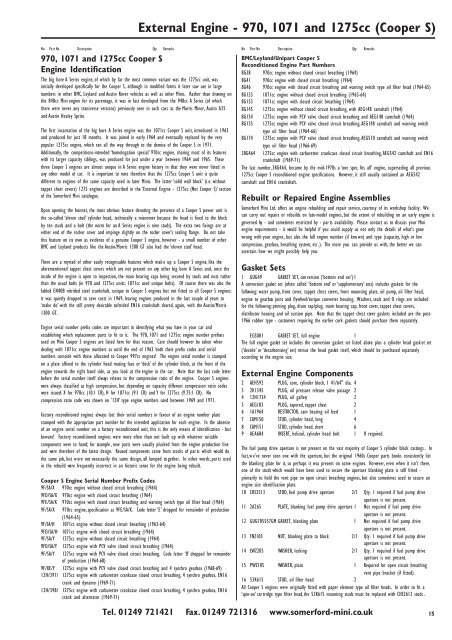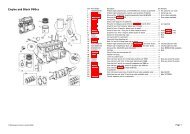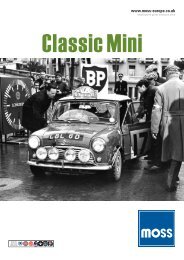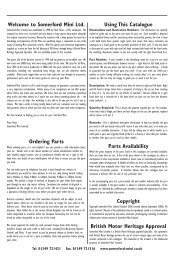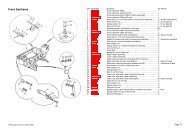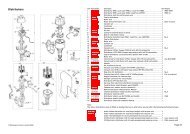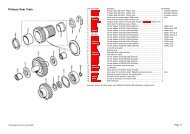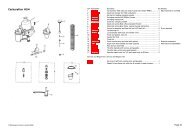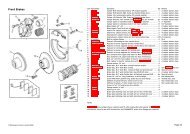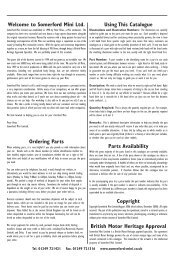Somerford Mini Ltd. Ordering Parts Using This Catalogue
Somerford Mini Ltd. Ordering Parts Using This Catalogue
Somerford Mini Ltd. Ordering Parts Using This Catalogue
You also want an ePaper? Increase the reach of your titles
YUMPU automatically turns print PDFs into web optimized ePapers that Google loves.
External Engine - 970, 1071 and 1275cc (Cooper S)<br />
No. Part No. Description Qty. Remarks No. Part No. Description Qty. Remarks<br />
970, 1071 and 1275cc Cooper S<br />
Engine Identification<br />
The big bore A Series engine, of which by far the most common variant was the 1275cc unit, was<br />
initially developed specifically for the Cooper S, although in modified forms it later saw use in large<br />
numbers in other BMC, Leyland and Austin Rover vehicles as well as other <strong>Mini</strong>s. Rather than drawing on<br />
the 848cc <strong>Mini</strong> engine for its parentage, it was in fact developed from the 948cc A Series (of which<br />
there were never any transverse versions) previously seen in such cars as the Morris Minor, Austin A35<br />
and Austin Healey Sprite.<br />
The first incarnation of the big bore A Series engine was the 1071cc Cooper S unit, introduced in 1963<br />
and produced for just 18 months. It was joined in early 1964 and eventually replaced by the very<br />
popular 1275cc engine, which ran all the way through to the demise of the Cooper S in 1971.<br />
Additionally, the competitions-intended ‘homologation special’ 970cc engine, sharing most of its features<br />
with its larger capacity siblings, was produced for just under a year between 1964 and 1965. These<br />
three Cooper S engines are almost unique in A Series engine history in that they were never fitted in<br />
any other model of car. It is important to note therefore that the 1275cc Cooper S unit is quite<br />
different to engines of the same capacity used in later <strong>Mini</strong>s. The latter ‘solid wall block’ (i.e. without<br />
tappet chest covers) 1275 engines are described in the ‘External Engine - 1275cc (Not Cooper S)’ section<br />
of the <strong>Somerford</strong> <strong>Mini</strong> catalogue.<br />
Upon opening the bonnet, the most obvious feature denoting the presence of a Cooper S power unit is<br />
the so-called ‘eleven stud’ cylinder head, technically a misnomer because the head is fixed to the block<br />
by ten studs and a bolt (the norm for an A Series engine is nine studs). The extra two fixings are at<br />
either end of the rocker cover and impinge slightly on the rocker cover’s sealing flange. Do not take<br />
this feature on its own as evidence of a genuine Cooper S engine, however - a small number of other<br />
BMC and Leyland products like the Austin/Morris 1300 GT also had the ‘eleven stud’ head.<br />
There are a myriad of other easily recognisable features which make up a Cooper S engine, like the<br />
aforementioned tappet chest covers which are not present on any other big bore A Series and, once the<br />
inside of the engine is open to inspection, the main bearing caps being secured by studs and nuts rather<br />
than the usual bolts (in 970 and 1275cc units; 1071cc used unique bolts). Of course there was also the<br />
fabled EN40B nitrided steel crankshaft, unique to Cooper S engines but not fitted to all Cooper S engines:<br />
it was quietly dropped to save costs in 1969, leaving engines produced in the last couple of years to<br />
‘make do’ with the still pretty desirable tuftrided EN16 crankshaft shared, again, with the Austin/Morris<br />
1300 GT.<br />
Engine serial number prefix codes are impor tant in identifying what you have in your car and<br />
establishing which replacement parts to fit to it. The 970, 1071 and 1275cc engine number prefixes<br />
used on <strong>Mini</strong> Cooper S engines are listed here for that reason. Care should however be taken when<br />
dealing with 1071cc engine numbers as until the end of 1963 both their prefix codes and serial<br />
numbers coincide with those allocated to Cooper 997cc engines! The engine serial number is stamped<br />
on a plate affixed to the cylinder head mating face or ‘deck’ of the cylinder block, at the front of the<br />
engine towards the right hand side, as you look at the engine in the car. Note that the last code letter<br />
before the serial number itself always relates to the compression ratio of the engine. Cooper S engines<br />
were always classified as high compression, but depending on capacity different compression ratio codes<br />
were issued: X for 970cc (10:1 CR), H for 1071cc (9:1 CR) and Y for 1275cc (9.75:1 CR). No<br />
compression ratio code was shown on ’12H’ type engine numbers used between 1969 and 1971.<br />
Factory reconditioned engines always lost their serial numbers in favour of an engine number plate<br />
stamped with the appropriate part number for the intended application for each engine. In the absence<br />
of an engine serial number on a factory reconditioned unit, this is the only means of identification - but<br />
beware! Factory reconditioned engines were more often than not built up with whatever suitable<br />
components were to hand; for example , new parts were usually plucked from the engine production line<br />
and were therefore of the latest design. Reused components came from stocks of parts which would do<br />
the same job, but w ere not necessarily the same design, all lumped to gether. In other words, parts used<br />
in the rebuild were frequently incorrect in an historic sense for the engine being rebuilt.<br />
Cooper S Engine Serial Number Prefix Codes<br />
9F/SA/X 970cc engine without closed circuit breathing (1964)<br />
9FD/SA/X 970cc engine with closed circuit breathing (1964)<br />
9FE/SA/X 970cc engine with closed circuit breathing and warning switch type oil filter head (1964)<br />
9F/SA/X 970cc engine, specification as 9FE/SA/X. Code letter ‘E’ dropped for remainder of production<br />
(1964-65)<br />
9F/SA/H 1071cc engine without closed circuit breathing (1963-64)<br />
9FD/SA/H 1071cc engine with closed circuit breathing (1964)<br />
9F/SA/Y 1275cc engine without closed circuit breathing (1964)<br />
9FD/SA/Y 1275cc engine with PCV valve closed circuit breathing (1964)<br />
9F/SA/Y 1275cc engine with PCV valve closed circuit breathing. Code letter ‘D’ dropped for remainder<br />
of production (1964-68)<br />
9F/XE/Y 1275cc engine with PCV valve closed circuit breathing and 4 synchro gearbox (1968-69)<br />
12H/397/ 1275cc engine with carburetter crankcase closed circuit breathing, 4 synchro gearbox, EN16<br />
crank and dynamo (1969-71)<br />
12H/398/ 1275cc engine with carburetter crankcase closed circuit breathing, 4 synchro gearbox, EN16<br />
crank and alternator (1969-71)<br />
BMC/Leyland/Unipart Cooper S<br />
Reconditioned Engine Part Numbers<br />
8G38 970cc engine without closed circuit breathing (1964)<br />
8G41 970cc engine with closed circuit breathing (1964)<br />
8G46 970cc engine with closed circuit breathing and warning switch type oil filter head (1964-65)<br />
8G133 1071cc engine without closed circuit breathing (1963-64)<br />
8G153 1071cc engine with closed circuit breathing (1964)<br />
8G145 1275cc engine without closed circuit breathing, with AEG148 camshaft (1964)<br />
8G154 1275cc engine with PCV valve closed circuit breathing and AEG148 camshaft (1964)<br />
8G155 1275cc engine with PCV valve closed circuit breathing, AEG148 camshaft and warning switch<br />
type oil filter head (1964-66)<br />
8G174 1275cc engine with PCV valve closed circuit breathing, AEG510 camshaft and warning switch<br />
type oil filter head (1966-69)<br />
38G464 1275cc engine with carburetter crankcase closed circuit breathing, AEG542 camshaft and EN16<br />
crankshaft (1969-71)<br />
The last number,38G464, became by the mid-1970s a ‘one spec. fits all’ engine, superseding all previous<br />
1275cc Cooper S reconditioned engine specifications. However, it still usually contained an AEG542<br />
camshaft and EN16 crankshaft.<br />
Rebuilt or Repaired Engine Assemblies<br />
<strong>Somerford</strong> <strong>Mini</strong> <strong>Ltd</strong>. offers an engine rebuilding and repair service, courtesy of its workshop facility. We<br />
can carry out repairs or rebuilds on late-model engines, but the extent of rebuilding on an early engine is<br />
governed by - and sometimes restricted by - par ts availability. Please contact us to discuss your <strong>Mini</strong><br />
engine requirements - it would be helpful if you could supply us not only the details of what’s gone<br />
wrong with your engine , but also the full engine number (if known) and type (capacity, high or low<br />
compression, gearbox, breathing system, etc .). The more you can provide us with, the better we can<br />
ascertain how we might possibly help you.<br />
Gasket Sets<br />
1 GUG49 GASKET SET, con version (‘bottom end set’) 1<br />
A conversion gasket set (often called ‘bottom end’ or ‘supplementary’ sets) includes gaskets for the<br />
following: water pump, front cover, tappet chest covers, front mounting plate, oil pump, oil filter head,<br />
engine to gearbox joint and flywheel/torque converter housing. Washers, seals and O rings are included<br />
for the following: priming plug, drain tap/plug, main bearing cap, front cover, tappet chest covers,<br />
distributor housing and oil suction pipe. Note that the tappet chest cover gaskets included are the post-<br />
1966 rubber type - customers requiring the earlier cork gaskets should purchase them separately.<br />
EGS001 GASKET SET, full engine 1<br />
The full engine gasket set includes the conversion gasket set listed above plus a cylinder head gask et set<br />
(‘decoke’ or ‘decarbonising’ set) minus the head gasket itself, which should be purchased separately<br />
according to the engine size.<br />
External Engine Components<br />
2 AEH592 PLUG, core, cylinder block, 1 41/64" dia. 4<br />
3 2K1345 PLUG, oil pressure release valve passage 2<br />
4 12H1734 PLUG, oil gallery 2<br />
5 AEG183 PLUG, tapered, tappet chest 2<br />
6 1A1964 RESTRICTOR, cam bearing oil feed 1<br />
7 CAM150 STUD, cylinder head, long 4<br />
8 CAM151 STUD, cylinder head, short 6<br />
9 AEA684 INSERT, helicoil, cylinder head bolt 1 If required.<br />
The fuel pump drive aperture is not present on the vast majority of Cooper S cylinder block castings . In<br />
fact,we’ve never seen one with the aperture, but the original 1960s Cooper parts books consistently list<br />
the blanking plate for it, so perhaps it was present on some engines. However, even when it isn’t there,<br />
one of the studs which would have been used to secure the aperture blanking plate is still fitted -<br />
primarily to hold the vent pipe on open circuit breathing engines, but also sometimes used to secure an<br />
engine size identification plate.<br />
10 CHS2513 STUD, fuel pump drive aperture 2/1 Qty. 1 required if fuel pump drive<br />
aperture is not present.<br />
11 2A265 PLATE, blanking fuel pump drive aperture 1 Not required if fuel pump drive<br />
aperture is not present.<br />
12 GUG705557GM GASKET, blanking plate 1 Not required if fuel pump drive<br />
aperture is not present.<br />
13 FNZ105 NUT, blanking plate to block 2/1 Qty. 1 required if fuel pump drive<br />
aperture is not present.<br />
14 LWZ205 WASHER, locking 2/1 Qty. 1 required if fuel pump drive<br />
aperture is not present.<br />
15 PWZ105 WASHER, plain 1 Required for open circuit breathing<br />
vent pipe bracket (if fitted).<br />
16 53K615 STUD, oil filter head 2<br />
All Cooper S engines were originally fitted with paper element type oil filter heads. In order to fit a<br />
‘spin-on’ car tridge type filter head,the 53K615 mounting studs must be replaced with CHS2613 studs.<br />
Tel. 01249 721421 Fax. 01249 721316 www.somerford-mini.co.uk<br />
15


